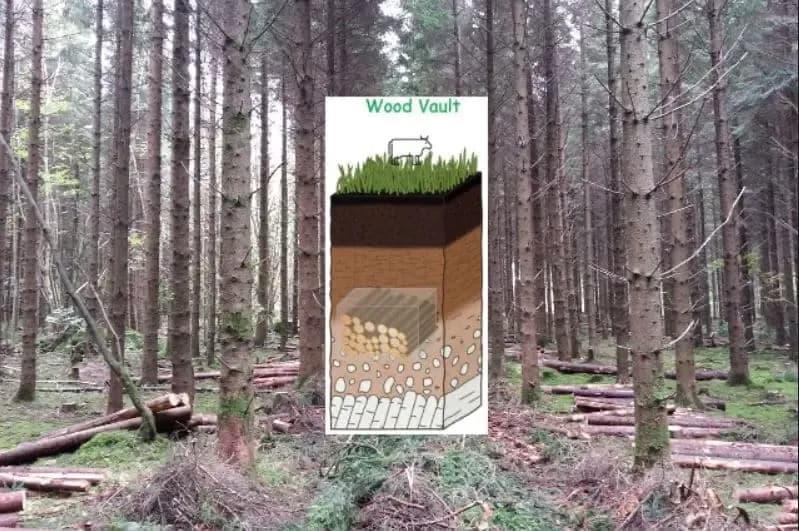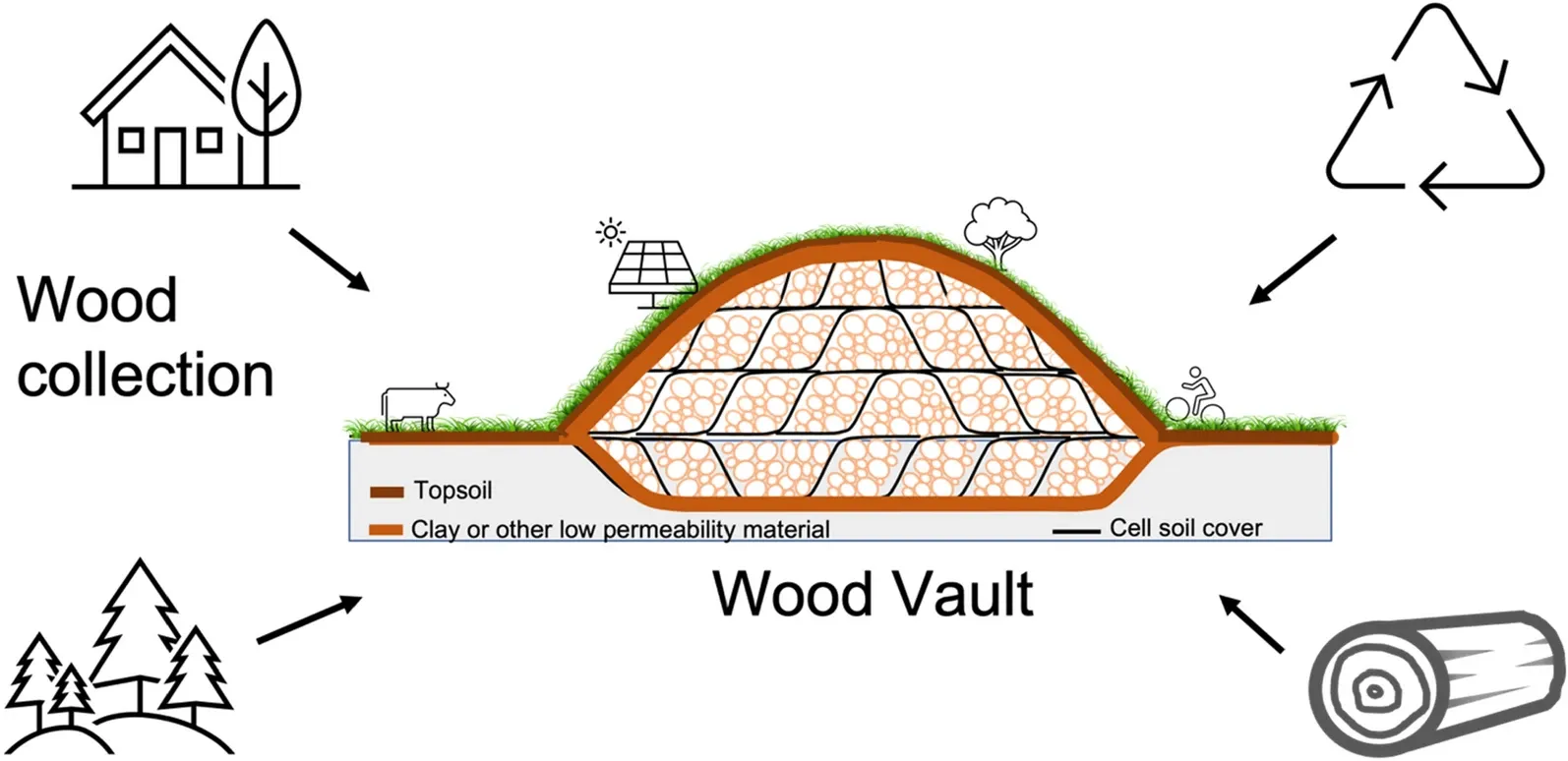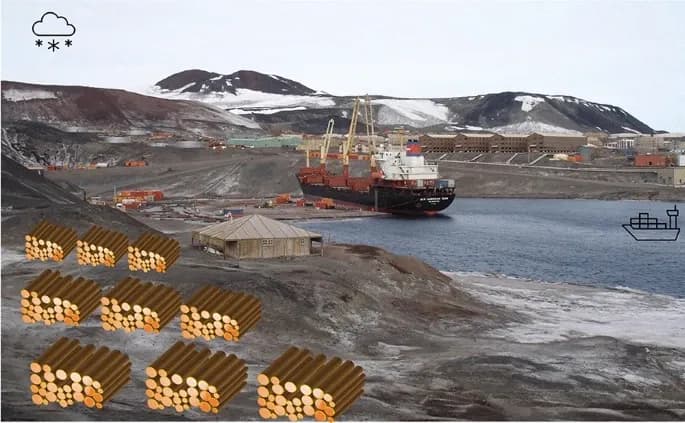Wood Vault: A Nature-Based Solution to Lock Away Carbon for Centuries
Introduction: What if trees could continue fighting climate change even after they’re cut down?
Every tree is a natural carbon sponge. It pulls carbon dioxide (CO₂) from the atmosphere and stores it in its roots, trunk, and leaves. But what happens when a tree dies or is cut? That stored carbon usually finds its way back into the air—through rotting, burning, or decomposition.
Now imagine this: what if, instead of letting trees decay, we safely buried them in specially designed vaults underground—locking away their carbon for hundreds, even thousands of years?
This is the idea behind the Wood Vault—a low-cost, nature-based carbon sequestration method that’s starting to gain global attention.
What Is a Wood Vault?

A Wood Vault is a carbon storage system where harvested or fallen wood is buried in a dry, oxygen-free underground vault. The goal is to prevent the wood from rotting or burning—two processes that release carbon back into the atmosphere.
The principle is simple: if you cut off oxygen and moisture, microbial activity slows down dramatically. This means the carbon inside the wood can stay trapped for hundreds to thousands of years.
It’s like putting carbon into a natural “bank vault,” ensuring it doesn’t return to the atmosphere.
Why This Matters: The Carbon Problem in Numbers

Let’s look at the bigger picture:
-
Earth is warming due to excess CO₂ in the atmosphere.
-
Trees absorb CO₂, but only as long as they’re alive or used in durable wood products.
-
When trees rot or burn, they release almost all that carbon back.
-
One cubic meter of dry wood stores about 1 tonne of CO₂.
-
If stored underground in the right conditions, that carbon can stay put for hundreds of years.
A 2022 study published in Carbon Balance and Management estimates that wood vaulting has the potential to sequester up to 3–5 billion tonnes of CO₂ per year globally—if done at scale with sustainable forest management.
How Does a Wood Vault Work?

Here’s a step-by-step breakdown:
1. Grow Trees
Afforestation or managed forests are grown using native species. Trees naturally absorb CO₂ as they grow.
2. Harvest Selectively
Only mature or excess biomass is removed to avoid ecological harm. Deadwood and invasive species can also be used.
3. Build the Vault
Vaults are trenches or pits built in dry, cool, oxygen-restricted environments—ideally in arid or semi-arid zones.
4. Bury the Wood
Logs are stacked in layers with minimal air pockets. Sometimes, biochar or clay layers are used to enhance protection.
5. Seal the Vault
The vault is sealed with a protective layer (e.g., clay or synthetic covers) to block air and water.
6. Monitor Over Time
Sensors or periodic checks track CO₂ leakage, moisture, and structural stability.
Real Benefits of the Wood Vault

Long-Term Carbon Storage
By preventing decomposition, each vault becomes a permanent carbon sink.
Low Energy Input
Unlike industrial carbon capture, Wood Vaults use no fossil fuels or chemicals.
Scalable with Nature
Wood vaults can be established on degraded lands, making them ideal for countries like India.
Job Creation
Harvesting, transporting, vault construction, and monitoring can create green rural jobs.
Community Engagement
Wood vaults align well with community forestry and circular bio-economy models.
Misconceptions: Wood Vault ≠ Deforestation

A major concern people have is: "Aren’t we just cutting trees and burying them?"
No. Wood Vaulting only works if we:
-
Grow more trees than we cut.
-
Harvest selectively and responsibly.
-
Use degraded land for vaults.
-
Treat vaulting as complementary to reforestation, not a replacement.
Think of it this way: instead of burning wood or letting it decay, you’re giving it a retirement plan.
What Makes a Good Vault Site?
-
Dry climate: Reduces rot and microbial activity.
-
Low water table: Prevents flooding and decomposition.
-
Remote or non-arable land: No competition with food production.
-
Community access: Enables participation, training, and local monitoring.
How CATCH Foundation Pioneered Wood Vaulting in India

At the CATCH Foundation, we believe in low-tech, high-impact solutions for climate action. One such initiative was undertaken in Manesar, Haryana, where we took a significant step toward India’s first practical application of the Wood Vault concept.
In collaboration with local authorities and in alignment with the government’s biodiversity restoration goals, we:
-
Removed Vilayati Kikar, an invasive species that was degrading native ecosystems—a step also prioritized by the Government of India’s ecological restoration initiatives.
-
Planted native tree species in its place, promoting biodiversity, soil health, and long-term ecological resilience.
-
Utilized buried biomass from removed Kikar in controlled conditions—mimicking the principles of Wood Vaulting—to explore passive carbon sequestration by storing deadwood without allowing it to decompose.
-
Engaged local community members as Paryavaran Rakshaks, who not only helped manage the forest and vault site but also became stewards of ecological restoration.
This project demonstrates that India can adopt innovative, scalable, and nature-based solutions for carbon sequestration—blending tradition with modern ecological science.
What Research Says
-
Carbon storage efficiency: Up to 90–98% of the carbon in wood remains locked after burial if vault conditions are met.
-
Cost per tonne CO₂ sequestered: Estimated between $10–50, much lower than industrial capture systems.
-
Time horizon: Sequestration is effective for 100 to 1,000+ years.
Learn more in this YouTube explainer
Challenges Ahead
-
Ecosystem impacts: Removing too much deadwood can affect forest biodiversity.
-
Land availability: Need clear land use policies and consent.
-
Carbon verification: Requires clear MRV (Monitoring, Reporting, Verification) protocols.
-
Public perception: Risk of misunderstanding as anti-forest or pro-logging.
That’s why education and transparency are key.
Conclusion: Plant, Protect, and Vault
The Wood Vault is not a silver bullet. But it is a powerful arrow in our quiver—especially when used alongside afforestation, clean energy, and conservation.
It’s a way to give trees a second life—not in smoke or rot, but in quiet service to the planet.
At CATCH Foundation, we believe it’s time India explores this model seriously. We have the science, the land, the people. Now, let’s vault the carbon—and the opportunity.
Call to Action
Interested in partnering with CATCH to pilot a Wood Vault in India? Want to support carbon sequestration projects that work with nature, not against it?
Write to us at: catchfoundations@gmail.com Website: www.catchfoundation.in
